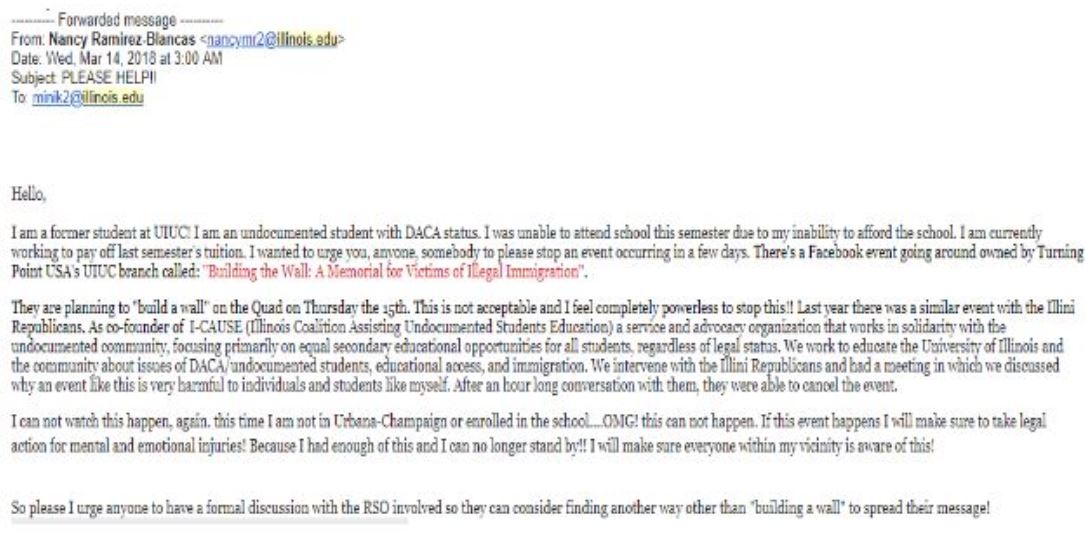
The “PayPal mafia” photographed at Tosca in San Francisco, October, 2007. “The group is decked out in gold chains and tracksuits, smoking cigars, drinking Maker’s Mark.”
The “mafia” were back row from left: Jawed Karim, co-founder of Youtube; Jeremy Stoppelman, Yelp CEO; Andrew McCormack, Laiola Restaurant managing partner; Premal Shah, President of Kiva; 2nd row from left: Luke Nosek, The Founders Fund managing partner; Kenny Howery, The Founders Fund managing partner; David Sacks, CEO of Geni and Room 9 Entertainment; Peter Thiel, CEO of Clarium Capital and Founders Fund; Keith Rabois, VP Business Development at Slide and original Youtube investor; Reid Hoffman, Founder of LinkedIn; Max Levchin, CEO of Slide; Roelof Botha, Sequoia Capital partner; Russel Simmons, CTO and co-founder of Yelp.
Max Levchin, a UIUC 1997 graduate in computer science, delivered the keynote at commencement in May. In announcing the choice, Chancellor Robert Jones termed Ukrainian-born Levchin “an inspiring entrepreneur.”
After four start-up failures during college and immediately after, Levchin moved to Silicon Valley, “since that’s where all my friends go, and sometimes their companies don’t fail.” There he co-founded PayPal, the money transfer service in 1998, and which eBay bought for $1.5 billion in 2002.
His PayPal co-founder was Peter Thiel, a Stanford grad and Silicon Valley billionaire. At Stanford (BA ’89, JD ’92), Thiel co-founded in 1987 the Stanford Review, a long-lived student conservative publication. Notable for his far right-wing, libertarian views, Thiel first came to national attention when he gave a prime-time speech at the 2016 Republican convention supporting Donald Trump, virtually the only Silicon Valley entrepreneur to back Trump.
PayPal made Thiel a multimillionaire; his early investment in Facebook in 2004 made him a billionaire. He has invested in more than 100 technology companies, including LinkedIn, Lyft, Spotify, Reddit, Airbnb, and SpaceX. Thiel “has by all accounts become one of the most powerful and financially successful people in Silicon Valley.”
Palantir is one of the most lucrative of these very lucrative companies. Co-founded in 2003 by Thiel and Jon Lonsdale, Palantir refers to an object that can be used to communicate with or see far away parts of the world. In J. R. R. Tolkien’s made-up Sindarin language in Lord of the Rings, it means “far-sighted.” Palantir specializes in big data analysis. Two projects are Palantir Gotham, which works on counter-terrorism analysis for the United States Intelligence Community (USIC), a federation of 16 government agencies, and the Department of Defense (DOD), among others; and Palantir Metropolis, which works for financial services firms, including banks and hedge funds. It is valued at over $20 billion.
Lonsdale, a Stanford grad (’03), former Stanford Review editor-in-chief, and former PayPal intern, is a “protégé” of Thiel, and considered the “the living embodiment of Silicon Valley.” He was also banned from campus in 2014, after he was accused of rape and Stanford concluded that he had “engaged in sexual misconduct and harassment.” However, a later review led Stanford to determine that he had not violated Title IX, and it lifted the ban in 2015. Thus, three out of the five founders of “one of Silicon Valley’s crown jewels” ran the same student newspaper, and no fewer than “23 current and former [Stanford] Review affiliates … have held positions at Palantir.”
Thiel and Levchin originated what later would become known as the “PayPal mafia” when they sat down one morning over breakfast in Palo Alto in 1998, Levchin to pitch his idea for what would become PayPal, an Internet-based money transfer company, and Thiel to invest.
They had definite ideas about the kind of people to recruit, and how to go about it. First, they went to their networks. “I hired friends from Stanford,” Thiel says, “and Max brought in people from the University of Illinois.” They looked for a specific kind of candidate. “They wanted competitive, well-read, multilingual individuals who, above all else, had a proficiency in math.” They also wanted “workaholics who were not MBAs, consultants, frat boys, or, God forbid, jocks.” Levchin recalls, “This guy came in, and I asked what he liked to do for fun. He said, ‘I really enjoy playing hoops.’” Levchin’s reaction? “‘We can’t hire the guy. Everyone I knew in college who liked to play hoops was an idiot.’”
It was all about “self-selecting for people just like you,” says Levchin. “He thinks like me, he’s just as geeky, and he doesn’t get laid very often. Great hire! We’ll get along perfectly.” For him, the perfect hire would “come in, eat crappy food all day, and sleep under their desks.” To say the least, PayPal was not welcoming toward women. “When it came time to hire a high-ranking female engineer, she turned out to be bad at Ping-Pong. Levchin took that as a lack of competitive fire, but grudgingly hired her anyway. She quit within six months.”
No fewer than “ten alumni from the newspaper [Stanford Revew]” “played a vital role in shaping the direction” of PayPal. Members of the PayPal mafia have gone on to found or co-found Yelp, YouTube, LinkedIn, Spacex, and Tesla. The “PayPal mafia,” in which Levchin played the consigliore to Thiel’s don, “is stacked full of Review alumni.”
Step back a minute and think about what we are talking about here. Thiel is a prime example of an “entrepreneur,” a person who engages in “entrepreneurship.” But what exactly is this? Consider Thiel’s 2014 book on entrepreneurship and startups, Zero to One. It is not about creativity, inventing technology, but about networking, marketing. Its major insight? “Choose the smartest people you know.” No wonder it “served as something of a bible among Trump campaign staffers. Leafing through the book … it’s immediately apparent why Trump’s aides were receptive to it. Thiel argues that savvy marketing is as important as a decent product.”
Now to be sure, creativity is involved in what people like Thiel do. But not of the sort, or in the way, that we generally think. This is because PayPal, Yelp, LinkedIn, and the like are not simply technological innovations. Key is that they combine technological solutions with a capitalist business model of how to “monetize,” to make money off of the innovation. The “creativity” comes in in the closeness of fit with which the (respective) app bridges virtual reality—the Internet—and our lived human/social reality. The closer the fit, the more the app can be marketed as “necessary,” as something that we can be taught to not be able to live without, and thus, the more willing we are to pay for it.
It is worth underscoring that “innovation” is not simply coming up with mathematical, technological solutions. It really is about “entrepreneurship,” which captures exactly the welding together of technological solutions with a profit-making business model to “monetize” the invention. The First Industrial Revolution in 18th century England consisted both of technological innovations in the textile industry, and the British government pushing the cheaply-priced textiles on colonial India. Both were necessary. Neither Steve Jobs, nor Bill Gates, nor Mark Zuckerberg are inventors so much as entrepreneurs who saw how to monetize others’ innovations (Xerox PARC, Windows, Facebook), and who ruthlessly crushed their competitors to establish market dominance.
The story of Silicon Valley—and of so much other American technology (the aerospace industry, for example)—is the story of how government played a crucial, especially research and development, role, only to turn the product over to private corporations to make a profit. The development of the Internet by the Defense Advanced Research Projects Agency (DARPA) and DOD is just one of many examples.
Of course, “entrepreneurship” is a misnomer, because it does not exist per se. It is not a thing, not an essence that can be quantified and packaged, handed down and plugged in and cooked up. People are forever trying to figure out how to package it in how-to books, teach it in business schools, design work spaces conducive to generating it, both in “interdisciplinary” settings on university campuses and “open” workplaces in businesses, all with the aim of coming up with a step-by-step recipe for automatically reproducing that which cannot be simply replicated.
Let us now return to Thiel and Trump. In October 2016, a week after Trump’s scandalous “Hollywood Access” tape was released, in which he bragged about “grabbing pussies,” Thiel contributed $1.25 million to his campaign. At the same time, Thiel apologized for saying things in his 1995 book, The Diversity Myth, such as that some alleged date rapes were “seductions that are later regretted.”
“More than two decades ago, I co-wrote a book with several insensitive, crudely argued statements,” he said. ”As I’ve said before, I wish I’d never written those things. I’m sorry for it. Rape in all forms is a crime. I regret writing passages that have been taken to suggest otherwise.” But three months later, at a 30-year anniversary event for the Stanford Review, Thiel told one former editor that “his apology was just for the media,” that “’sometimes you have to tell them what they want to hear.’”
After Trump’s election the following November, Thiel and his buddy network played a prominent role in the transition. It was said that he was “deeply involved in the transition’s internal workings,” and that his “fingerprints are all over the administration.” So many of Thiel’s people worked on the transition, in fact, that his San Francisco employees started calling him “the shadow president.”
Thiel likes to work behind the scenes, but his work on the transition was on display in December, 2016, when he organized a technology summit meeting with Trump in Trump Tower that included the likes of Apple CEO Tim Cook and Google CEO Larry Page. A photo from the meeting shows “Trump gently petting his [Thiel’s] hand as the tech executives and a slew of reporters looked on in astonishment.”

Peter Thiel with Donald Trump petting his hand at so-called technology summit, Trump Tower, New York, December, 2016.
Also along for the ride was Charlie Kirk, 24, founder of Turning Point USA, “dedicated to training young conservatives … and plugging them into the right networks.”
Thiel attended the “Deploraball” held immediately before the January inauguration, which celebrated the union of the alt-right and alt-lite. Co-organized by Internet troll Mike Cernovich and Stanford grad Jeff Giesea (’97), a former Stanford Review editor-in-chief and former Thiel Capital Management employee, it took its name from Hillary Clinton’s reference to Trump supporters as a “basket of deplorables.” The phrase was immediately turned against her by Trump supporters, who among other things uploaded on Twitter a movie poster, The Deplorables, parodying The Expendables, which included the Internet meme Pepe the Frog’s face among those of members of the Trump family and other figures popular among the alt-right.
“A mostly young, white, open-bar-lubricated crowd in suits, tuxedos, and ball gowns,” the Deploraball “had all the trappings of a Trump rally … the booming cheers, the chants (“USA! USA!” “Lock her up!”), the hats. It was like a Twitter feed exploding into real life.” Speeches were by James O’Keefe, the conservative provocateur who secretly records undercover audio and video encounters, and who Thiel once funded; law-and-order enforcer and hard-right Milwaukee county sheriff, David Clarke; Jim Hoft, founder of the far-right Gateway Pundit, which received an official White House press pass to attend daily briefings. Their White House correspondent would be Lucian Wintrich, author of the salacious “Twinks4Trump” photographic series of “scantily clad young men in ‘Make America Great Again’ hats,” who will sit next to New York Times and Washington Post correspondents at the White House.
Deploraball attendees ranged from Bill Mitchell, “Twitter’s favorite Trump booster,” to Michael Flynn, Jr., son of former national security advisor Michael Flynn, who has pled guilty to lying to the FBI and is cooperating with special counsel Robert Mueller’s investigation. Flynn, Jr, pushed the PizzaGate fake news story alleging that Hilary Clinton was engaging in sex trafficking in the basement of the restaurant, which led one social media follower to drive to the pizza parlor, and enter with a rifle, presumably to break up the alleged ring and free the children.
Thiel arrived with a small entourage, and left after a half-hour, “refusing to answer questions from two reporters chasing him down the hall.” Other attendees included “Pharma Bro” Martin Shkreli, who raised the price of a drug in 2015 by a factor of 56, was convicted of securities fraud, and is currently serving a seven-year prison term. There was also Paul Ryan’s Republican primary election challenger, Paul Nehlen, an avowed anti-semite and white supremacist, who was running to the hard-right of Ryan’s own Ayn Rand libertarian right, before Ryan announced in April that he would step down as House Speaker and not seek reelection. Rand represents another form of libertarianism that has influenced, besides Ryan, Trump, Rex Tillerson, and Mike Pompeo.
As one Deploraball participant said, “The thing about the alt-right and the alt-light is we all have the same style, in that we’re un-cucked,” that is, not conservative but hard right. The opposite of “cucked,” it refers literally to a submissive man sexually cuckolded by a woman. By extension, “un-cucked,” which originated on websites such as 4chan, is used by white nationalists to insult Republican politicians deemed insufficiently conservative. “The term has come to be more generally used for Trump supporters who think swastikas are good; in this context, it’s just a hip name for white supremacists.”
The significance of the Deploraball is that in celebrating together, the alt-right and alt-lite demonstrated that the differences they otherwise deceitfully, coyly claim differentiate them are simply not true. What unites the alt-right and alt-lite are their common ideas, beliefs and goals; only their modus operandi differs. The alt-right, like the neo-Nazis at Charlottesville, goes beyond the alt-lite verbal and online violence engaged in by TPUSA, for example, and embraces physical violence.
Arising largely from the deep Internet and social media, and having developed a vocabulary of terms, Internet memes, and symbols, including hand gestures, the alt-right and alt-lite have been gaming the mainstream media (MSM) and the rest of us beginning with the 2016 campaign. This entire period can be viewed as one long, fitful, mostly unsuccessful decoding by the MSM of what all along has been the alt-right alt-lite’s shared trappings, symbols, and practices of white supremacy. Usually they have been discussed according to the rules of traditional journalism, but the problem is that the alt-right alt-lite play according to a whole new set of rules. We were, are, and continue to be conned. Thus, TPUSA founder Charlie Kirk employs a white power hand gesture but denies a connection with the alt-right.
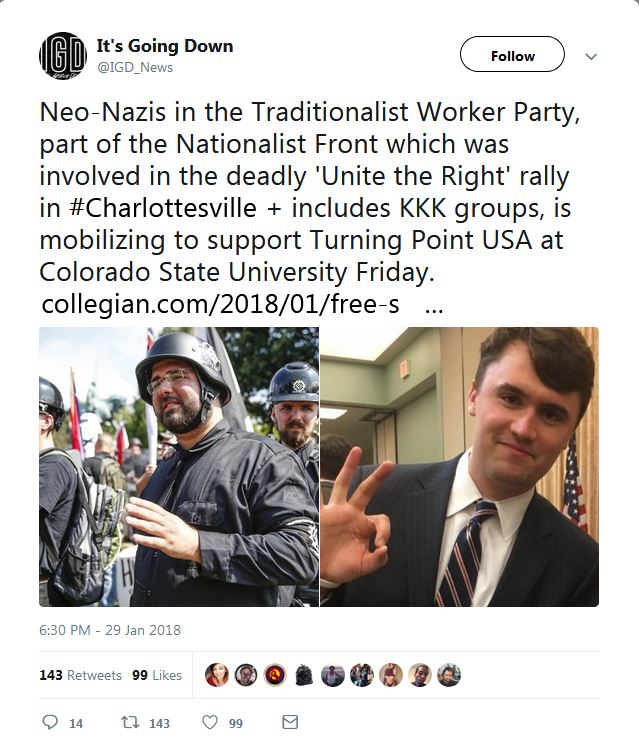
On right, Charlie Kirk appropriates the “OK” sign to make a “white power” hand gesture. The three upright fingers form the letter “W,” and the thumb and index finger form the letter “P.
Only hours after the Deploraball, Trump was inaugurated. Back then, it took us awhile to decode Steve Bannon and Steven Miller‘s Batman the “Dark Knight” inaugural speech, the Hungarian fascist ribbons then-advisor Sebastian Gorka wore, and Kellyanne Conway’s buttons on her red and blue suit; in short, the white supremacy hiding in plain sight.
Let us look some more at Thiel and the Stanford Review. We may say that Thiel is the Stanford Review, and the Stanford Review is Thiel. As one former editor put it, “[Thiel] sees the Review as his people.” Thiel’s “work and outlook today can be traced directly to his college years.” He funds the Review, although he is by no means the only one. Between 1997 and 2010, it averaged about $65,000 per year in contributions. In contrast, the Public i receives about $3,000 per year from underwriters. Thiel also entertains editorial board members. He hires Review graduates. He recruits them into his network. “Of course there’s a Review network,” says one network member, “and of course there is a connection between the group’s mission and the types of projects those people go on to do together afterwards!”
In Silicon Valley, “Review alumni have built an infrastructure that spans many billions of dollars in both company market value and personal wealth.” Of the 58 people who have served as Review editor-in-chief, at least 25 have worked or interned for at least one company founded or cofounded by Thiel or Joe Lonsdale; most of them have worked for several. Talk about connections. “Almost 200 employment and investing relationships” have been identified “between Review affiliates to 40 different institutions that are founded by Thiel or Lonsdale or otherwise feature multiple Review alumni prominently, virtually all of which are in Silicon Valley.”
For 30 years, the Review has fought against Stanford’s liberal and left majority. For Thiel, “an inspiration for founding the Review” was the late 1980s controversy over replacing the “Western Culture” academic program with a “Cultures, Ideas, and Values” one. The latter program mandated more works by female and non-white authors, plus hiring more non-white faculty to teach in it. All this was criticized by the Review, which wanted to “actually strengthen the current program’s focus on the West.” Throughout its history, the Review, instead of criticizing what it terms “supposed ‘institutionalized racism,’” has focused its critique on what it alleges is Stanford’s “institutionalized liberalism.”
Past and present editors agree that a big moment in the Review’s history occurred in 1995, when it sued Stanford over its speech code that banned bigoted speech based on race and sex, and won. The local county superior court struck down the code as “unconstitutionally broad and based on content.” Attempts to ban hate speech regularly fall to absolutist free speech interpretations of the First Amendment. In typically twisted right-wing rhetoric, the Review described the outcome as “a victory for academic freedom and free speech.”
Thiel prizes his privacy. The gossip news site Gawker reported negatively on his politics, and then outed him as gay in 2007. In 2012 Gawker published a sex tape of wrestler Hulk Hogan, who sued for invasion of privacy plus $100 million in damages. In 2016, Hogan won the suit plus $140 million in damages, a previously unheard-of amount. Gawker was forced out of business, and its editor declared bankruptcy in the same year. Also in 2016, it was revealed that Thiel had secretly contributed over $10 million to lawsuits against Gawker. He called his support in the Hulk Hogan case “one of my greater philanthropic things that I’ve done.”
Yet Thiel “has often talked about protecting freedom of speech.” When it comes to the Stanford Review and the other libertarian groups he supports, he is a free speech absolutist—that is, he argues against any restrictions on free speech whatsoever. In the Gawker case, however, “he said he did not believe his actions were contradictory. ‘I refuse to believe that journalism means massive privacy violations.’” This is bullshit. You can’t have it both ways. Such statements are a clear case of ‘free speech for me, but not for thee.’ It reveals his libertarian free speech claims, and those of libertarian groups he supports, for the total hypocrisy that they are.
The New York Times let him off the hook completely. All they said was that Thiel’s covert backing in the Hulk Hogan case “has raised a series of new questions about the First Amendment as well as about the role of big money in the court system,” specifically where third parties “pay for other people’s lawsuits.” In other words, one legal system for billionaires, another for the rest of us.
Both Thiel and the Review are intentionally contrarian and provocative. One writer asks, “Does the Review have a limit on how far it will go against the grain?” In 2016, the editors were “very internally divided” over sponsoring notorious provocateur Milo Yiannopoulos. Some did “not believe that being provocative is a virtue in itself and didn’t think that Milo brought enough original thought to justify an invitation.”
Others favored his appearance, saying, “Best-case scenario is that the SJWs [Social Justice Warriors, a pejorative term for confrontational and highly vocal leftists on social issues] freak out and we get another Berkeley,” referring to the February, 2017 confrontation there pitting supporters of Yiannopoulos against Antifa counter-demonstrators that resulted in $100,000 damage. Thiel himself has met with Yiannopoulos, and also contributed a blurb to his book, Dangerous: “If you don’t use your freedom of speech, one day you might find that it’s gone. Buy this book while it’s legal.” In the end, the Review decided against inviting Yiannopoulos.
It is entirely in keeping with its ethos and track record, therefore, that the Review in January, 2018 published a hit piece attacking Stanford professor David Palumbo-Liu, “Antifa Thugs Find a Champion and Leader in Stanford Professor.” The Review was especially exercised that Palumbo-Liu, along with Purdue professor Bill Mullen, had co-founded in August, 2017 the Campus Antifascist Network (CAN), days after the alt-right “Unite the Right” rally in Charlottesville that left one woman dead when a demonstrator drove his car into a crowd.
For the Review, the CAN co-founders “can mince words all they want: their organization is undeniably a chapter of a terrorist group, championing the same kinds of violent resistance that have muzzled free speech across the country. “
Palumbo-Liu responded in the Stanford Daily student newspaper with an op-ed, “Why we have free speech on university campuses, and why I will never take a call from the Stanford Review again.” He said that “[w]hen the Review writes: ‘Do we really want to bring this type of vigilante thuggery to Stanford by enabling a professor who promotes it?,’ it puts words I did not speak into my mouth, arrogantly ignores the facts, engages in McCarthyist guilt by association and attributes motives and behaviors without any proof whatsoever, and then its lies and distortions appear on Jihad Watch, they open the door to the hate mail, phone calls, threats and harassment that not only I, but also my family, am now subjected to.”
He was especially upset with the Review’s bait and switch tactics. They approached him to talk about CAN, but then wrote an out-and-out hit piece—hence “why I will never take a call from the Stanford Review again.” Not only does this exemplify how the alt-right alt-lite manipulates “free speech” to serve its own partisan ends, it also demonstrates how such organizations—including TPUSA UIUC—directly and indirectly aid and abet hate speech, all the while trumpeting their right to “free speech.” “The debate over free speech for them [the alt-right, including the Stanford Review] is merely a pretext to gain publicity for themselves,” Palumbo-Liu wrote. “They care little or nothing about free speech—hence their campaigns to dox, stalk, harass and silence critics, affixing misleading and mendacious labels to them.”
Officially, Stanford did not defend Palumbo-Liu as a faculty member, and holder of an endowed chair no less. “Despite this new and alarming phenomenon on campus [conservative groups, far-right organizations and white supremacists are all trying to intimidate faculty and students], university administrators seem loathe to aggressively protect their faculty. My own university has left it to me to press charges, and has chosen not to make any public comment on the Stanford Review’s defamation of my character.” However, individuals on campus did. Six Stanford Law School professors, who have “political views ranging across the political spectrum,” and who while not agreeing with Palumbo-Liu “on many issues,” argued nonetheless that “there is no evidence that he has advocated violence or is a member of a terrorist group.”
In addition, an open letter supporting Palumbo-Liu signed by nearly 750 individuals affiliated with Stanford called on the university to “enunciate a strict code of ethics for journalists, distinguishing between opinion pieces and news reporting.” This distinction goes to the heart of the debate over “fake news,” but it is not known whether any action was taken.
Earlier, both Palumbo-Liu and Mullen had been vocal supporters of professor Steven Salaita during 2013-2015, when UIUC withdrew a tenured job offer that led the AAUP to censure UIUC, before it finally settled with Salaita.
CAN also issued a statement January 22, 2018 in support of UIUC history grad student Tariq Khan, harassed by TPUSA and disciplined by UIUC. “The Campus Antifascist Network (CAN) condemns in the strongest possible terms the campaign of vilification and harassment directed at Tariq Khan, a doctoral student in the History Department at the University of Illinois, Urbana-Champaign, instigated and sponsored by Turning Point USA (TPUSA) and its associated media arm, Campus Reform.”
CAN demanded “that the University’s Office of Student Conflict Resolution (OSCR) drop all university disciplinary and ‘criminal damage’ charges against Tariq Khan and issue a condemnation of TPUSA’s hateful slander and defamation.” It characterized TPUSA as “a reactionary, non-university-affiliated group that regularly employs aggressive and invasive tactics, deeply misleading accounts, public intimidation, and the ruse of ‘defending free speech’ in order to call for the expulsion of academics on scant or no evidence and to censor academics with whom they disagree.” It noted that TPUSA “is responsible for generating hateful, sexist, racist, and transphobic campaigns, typically directed at universities,” and that “far from a ‘grassroots activist’ movement, TPUSA is bankrolled by politically vindictive billionaires and think tanks who target higher education in order to promote regressive and racist political agendas.”
CAN pointed out that “perhaps most disturbingly, TPUSA founded and maintains the McCarthyist online ‘Professor Watchlist,’ which criticizes faculty who promote racial diversity and multiculturalism in the classroom and has led to numerous instances of cyber-harassment, death threats, and involuntary administrative leaves. The ‘Professor Watchlist’ has been condemned by the American Association of University Professors: ‘The Professor Watchlist, which purports to expose faculty who “advance leftist propaganda in the classroom,” poses a clear threat to academic freedom. Such lists have been used to harass and intimidate faculty, and have a chilling effect on academic freedom and free speech.’ Thus far, over 12,000 faculty members have signed the AAUP statement of protest.”
Professor Jay Rosenstein was put on the Professor Watchlist for his anti-Chief Illiniwek activism. Regarding Tariq Khan, “TPUSA’s efforts to purportedly defend ‘free speech’ on college campuses while simultaneously pressuring the University of Illinois to dismiss Mr. Khan is a case in point … Given that UIUC has experienced an uptick in explicitly racist activity on campus in the last few years—with nooses and three large swastikas being placed on buildings in 2016, in addition to the informal use of the offensive ‘mascot’ Chief Illiniwek, which Tariq Khan protested in November 2017—it is imperative that you take these necessary steps to prevent the further encroachment of extremist hate groups.”
Not only Khan but his department has been targeted. The “inflammatory and irresponsible smear of Mr Khan has affected the everyday business of your campus. The Department of History at UIUC has also been harassed since this incident. TPUSA/Campus Reform posted links to the department’s public website with Khan’s contact information. Khan and others in the department have since received threatening and harassing emails, including death threats, threats of physical violence, and racist and Islamophobic language. These threats were reported to the University Police by Khan and by department faculty.” In conclusion, “We remind the OSCR that bending to TPUSA’s demands in this case [concerning Tariq Khan] will only further signal the University’s willingness to sacrifice the very principles upon which it is founded.”
From fall 2017 until April 2018 UIUC generally and OSCR in particular continued its disciplinary actions against Khan, failing to defend both him and the History Department. Then in April, 2018, TPUSA filed a lawsuit against the University, alleging that TPUSA members Minik, Valdez, and Nelson’s free speech rights had been attacked when OSCR issued restraining orders against them, and Khan filed a counter-suit. In June, UIUC pushed back, denying that TPUSA members’ free speech rights were violated, and called for the case to be dismissed. “While publishing a news article is protected, comments about Khan’s children, his age, and kicking and beating him do not rise to the level of matters of public concern” that warrant protection from retaliation.
According to the TPUSA lawsuit, Valdez called Khan a “50-year-old man,” and said, “Don’t you have kids to look after,” at the fall 2017 Trump protest. Later Minik tagged Khan on a meme of Trump that said “Get him out of here … beat the shit out of him … I’ll pay the legal fees.” Last February, Valdez liked a Facebook post from a friend that said he could “beat his ass for you bro” and commented “Do it ASAP.”
TPUSA’s response? “These posts were sarcastic,” and “the social-media threats are protected speech.”
In his counter-suit, Khan claims that TPUSA posted his Facebook page and university address online “at sites known to be supported by racists and hate-group supporters.” As a result, he received over a dozen threatening emails, including “You are so screwed little man. You bees a tuff guy on da video. Grow up. Seek guidance from your Imam and good luck with your career at McDonalds.”
The good news is that at least the person who wrote the University’s legal response to TPUSA’s suit gets it. This marks the first time UIUC has taken on TPUSA, and one of only a very few instances in which any university in the country has gone after TPUSA. However, UIUC did not defend Khan, it defended itself when sued by TPUSA.
In the case of Palumbo-Liu and CAN, the Stanford Review refused to accept the distinction between Antifa and antifascist, basically arguing that ‘if it [CAN] quacks like a duck, then it is a duck [Antifa].’ The terms are close, and while there is a world of difference between Antifa and CAN regarding the use of violence, CAN’s use of the term can be seen as needlessly provocative. The same is the case with Black Rose, the avowed anarchist group Tariq and Kristina Khan belong to. While Black Rose’s anarchism is largely theoretical, and while the group is more accurately described in practice as social democratic, eschewing violence and endeavoring to build broad-based coalitions, nonetheless the name can also be seen as more provocative than necessary.
Another UIUC grad who like Max Levchin moved to Silicon Valley is James Damore (’10), who went to work at Google. Coming from Illinois, it is unclear what his reaction was to Silicon Valley culture. On the one hand, Google was touting its now-discarded mantra, “Don’t Be Evil.” The Valley was also earning a reputation for its party culture, and especially its treatment of women. On the other hand, Google and more generally the so-called “Big 5” tech firms (Apple, Amazon, Google, Facebook, and Microsoft) were faulted increasingly for their laser-like focus on the bottom line, putting profits from ad revenue over privacy protections, and their generally cavalier attitude towards user data.
Yet calls for greater oversight and stricter regulation along the lines of European Union strictures on these companies made virtually no headway before the 2016 presidential campaign and its aftermath concerning Russian meddling in the election. In ways analogous to the failure after the 2008-2009 Great Recession to rein in Wall Street banks that had led to the 2009 economic crash, because they were “too big to fail,” so, too, it was as if companies like Google were “too big to curb,” too big for government to regulate.
Damore made none of these criticisms, however. Instead, what concerned him about Google were other, more prominent aspects of its workplace, namely, its “liberal” culture of “diversity.” Regarding Silicon Valley’s “liberal” politics, already in May, 2016 Facebook CEO Mark Zuckerberg included board member Peter Thiel in a meeting with political conservatives to push back against their criticism that Facebook tilted Left and excluded conservative news as baseless.
That was then. Now, in 2018, in light of revelations concerning how Facebook was successfully manipulated during the 2016 campaign both domestically and by Russia, plus the pro-Trump uses to which Cambridge Analytica put Facebook user data, the issue is the extent to which Facebook indirectly and inadvertently aided Trump’s election. There is widespread agreement about social media collusion. Few, if any, publicly say, however, that it flipped the election to Trump.
Damore did not concern himself apparently with how Google and other “Big 5” Silicon Valley companies were manipulated by the Right. Rather, he worried about these “liberal” companies and their push for “diversity.” Now, Silicon Valley was and is notoriously male dominated, it systematically pays women less, and it is rife with sexual harassment. Thus, these “liberal” companies pushed for “diversity” to combat gender inequities and improve gender relations. But Damore criticized not the imbalance between the number of male and female employees, not the lack of diversity, but instead the attempts to increase diversity through hiring more women. Furthermore, Damore’s criticisms came largely from his libertarian and right-wing ideology.
Damore put his thoughts down in a 2017 10-page memo, “Google’s Ideological Echo Chamber.” Few commentators have actually looked at the memo in detail, let alone discussed his use of the science behind it. Damore was broaching large issues in a short paper. The memo was not an article with a fully documented argument assessing the literature pro and con. It was a series of assertions, a mishmash of his acknowledged libertarian beliefs, articles found on right-wing websites, plus studies in evolutionary biology that themselves reflect the controversies in the field. Damore used “Wikipedia entries, blog posts, academic research, and online discussion boards, plus news articles from the The Wall Street Journal , The Atlantic and The New Yorker , as well as smaller publications like libertarian magazine Quillette.”
Damore argued that many fewer women worked in technology because of “socially-constructed” gender differences, which were “in part due to biological causes,” in personality differences predicted by evolutionary psychology, but he did not say how large a part these differences played. Instead, he focused on alleged personality differences, which include women generally having a stronger interest in people rather than things, the tendency for women tend to be more social, more artistic, and more prone to neuroticism (higher anxiety, lower stress tolerance).
Damore argued that men and women differed on average, not that every male and female differed. However, such character traits are notoriously difficult to define precisely, and it is even more difficult to link them causally to biology. This is the root cause of controversies within evolutionary psychology. Moreover, in note four and elsewhere in the memo, he argued that personality differences are not only biological in origin, but universal across cultures. Damore, however, soldiered on, blithely concluding that “we need to stop assuming that gender gaps imply sexism,” and labeling corrective reverse discrimination as “authoritarian.”
Some faulted him for cherry-picking his facts, others for simplistic assertions, and still others for relying on studies regarded as on the margins of consensus within the discipline of evolutionary psychology. One author reported to “Damore what the psychologists [told him] about his memo: that there is no agreement among the experts about the extent to which men and women have different psychological profiles; nor is there any consensus about whether any differences can be attributed to nature, nurture or a complex mix of the two. The psychologists do not agree on what, if any, impact these differences might have on career outcomes … ‘Part of the issue is, he’s a software engineer,’ says Janet Hyde, a psychologist at the University of Wisconsin. ‘He attached himself to what is actually a relatively small chunk of the psychological research literature and was unduly influenced by it.’ … Damore bristles when I accuse him of cherry-picking studies that support his view and ignoring the mountains of evidence that contradict it. ‘Even if I presented both sides equally, the very fact that I presented the ‘evil’ side would have caused controversy.’”
The gravamen of Damore’s charge against “Google’s ideological echo chamber” was that it was due to “confirmation bias,” which he discussed in a section titled tellingly, “Why we’re blind.” Conformation bias is the tendency to lend more credence to data and arguments that correspond to our beliefs. That “the overwhelming majority of humanities and social sciences lean left (about 95% ) … creates enormous confirmation bias, … and maintains myths like social constructionism and the gender wage gap.”
Damore admits in note two that he, too, may be biased in the opposite direction, but does not ask himself why this may be so. Instead, he doubles down on what he terms “veiled left ideology,” which he discusses in footnote seven. “Communism promised to be both morally and economically superior to capitalism, but every attempt became morally corrupt and an economic failure. As it became clear that the working class of the liberal democracies wasn’t going to overthrow their ‘capitalist oppressors,’ the Marxist intellectuals transitioned from class warfare to gender and race politics. The core oppressor-oppressed dynamics remained, but now the oppressor is the ‘white, straight, cis-gendered patriarchy.’”
In one paragraph, therefore, Damore purports to sum up the failed history of “Communism,” and to dismiss the entirety of “gender and race politics.” The breathtakingly simplistic intellectual leaps, rivaled only by an apparently depthless knowledge of history, society, politics, race, and gender is simply astonishing.
Unsurprisingly, Google CEO Sundar Pichai responded that “portions of the memo violate our Code of Conduct and cross the line by advancing harmful gender stereotypes in our workplace.” He continued by saying that “To suggest a group of our colleagues have traits that make them less biologically suited to that work is offensive and not OK. It is contrary to our basic values and our Code of Conduct, which expects ‘each Googler to do their utmost to create a workplace culture that is free of harassment, intimidation, bias and unlawful discrimination.’” Pichar concluded, “Our co-workers shouldn’t have to worry that each time they open their mouths to speak in a meeting, they have to prove that they are not like the memo states, being ‘agreeable’ rather than ‘assertive,’ showing a ‘lower stress tolerance,’ or being ‘neurotic.’”
Google fired Damore, and he sued Google, but his memo had already gone viral. Damore’s memo is significant not for the importance of what he wrote, which is questionable to say the least, but due to the response his memo elicited, chiefly on the Right, from those who were already reacting against liberal “political correctness.” It hit a nerve, and entered the right-wing echo chamber where it was passed around, although not critically examined.
The alt-right alt-lite acts as though “conservatism” and “libertarianism” constitute a well-thought-out political philosophy that, ipso facto, deserve to be debated on a par with “liberalism.” Whatever the case may have been earlier, that is not the case today. To overstate the situation, but not by much, conservatism and libertarianism today mostly traffic in sound bites, mantras, and slogans, because they have no serious ideas to speak of, they are intellectually bankrupt.
A good example is how the Right responds to alleged left-wing “confirmation bias.” If the media, if the academy is more “liberal” than “conservative,” then simply hire more conservatives, they argue. This is as simplistic as it sounds. It is crude reverse discrimination of precisely the sort that conservatives would howl about if it were liberals advocating it.
In the case of academia, historian Joan Scott responds by crucially distinguishing between free speech and academic freedom. Academic freedom, which is about quality, has nothing to do, she contends, with free speech, which is about content. “Freedom of speech is not about that [the goal of academic inquiry: getting a matter of fact right]. Freedom of speech is about expressing your opinion, however bad or good, however right or wrong.” As a free speech absolutist, she would support, however reluctantly, far-right extremist Richard Spencer speaking on campus. “I would have a hard time banning even Richard Spencer [founder of the white nationalist movement] from speaking on a university campus, however hateful and dangerous I find his ideas.” In short, if for Scott the answer to free speech is more speech, then the answer to alleged confirmation bias is more science.
This discussion is relevant because Damore’s ideas—that gender differences are rooted in biology, for instance—are all-too-widespread on the Right. For example, in a fall 2014 discussion at Thiel’s home of Charles Murray’s controversial book on IQ, The Bell Curve, he wanted to “entertain” the thought that there was a biological reason for racial gaps in test scores, according to those present.
The controversy over Damore’s memo was not helped by his diagnosis in graduate school “with autism, although he was told he had a milder version of the condition known as ‘high-functioning autism.’” He admits to being socially awkward, has a tendency to let others coopt and use him (psychologist Jordan Peterson, who “has acquired a huge following online by railing against political correctness,” right-wing photographer Peter Duke), and “has a strange habit: when he disagrees with something an interviewer says, he does not interject but instead moves his head silently from side to side. He tends to fall silent when in fact he disagrees with others.” It has also been pointed out that Thiel likely is also on the autism scale.
As for Damore, after he was fired, he joined the nation-wide, conservative, college talk circuit. He appeared at UIUC April 5 at a TPUSA event hyped for months and co-sponsored by the libertarian Ayn Rand Institute and the Leadership Institute, a right-wing think tank.

TPUSA appearance by James Damore, former Google employee, co-sponsored by the libertarian Ayn Rand Institute and the Leadership Institute, a right-wing think tank, April 5, 2018.
TPUSA’s Andrew Minik attended a Leadership Institute program, and is involved in the Atlas Society, a program to “bring the literature of Ayn Rand into the classroom.” The Institute has “graduated,” among others, notorious conservative underground videographer James O’Keefe (Thiel has given him money), Bush strategist Karl Rove, Christian Coalition leader Ralph Reed, Mitch McConnell (R-Kentucky), and Americans for Tax Reform President Grover Norquist.
Instead of simply showing up at a lecture on campus, prospective attendees were required to download a free ticket and “bring an ID and ticket before entering the venue.” So much for free speech. This is how TPUSA handled attendance and security. One photo of the crowd posted on social media shows that 30 people attended.
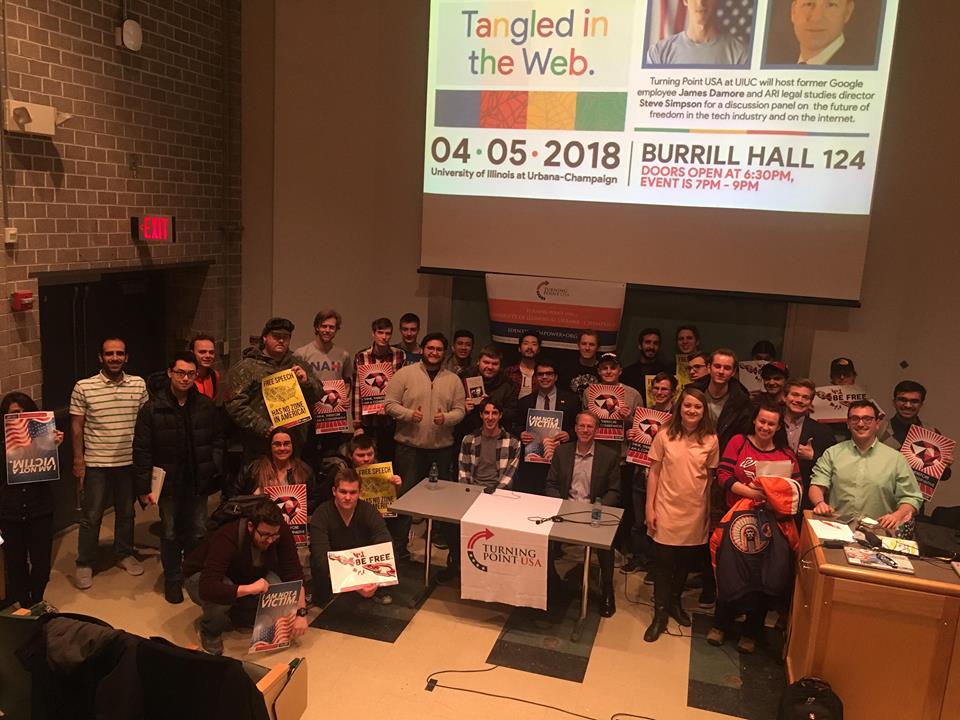
UIUC TPUSA post-event photo of audience and presenters, numbering 33 in all. Damore (l) and Simpson sitting at table, TPUSA members Joel Valdez standing to his right with both thumbs up, Madelyn Hibbard to Simpson’s left, and Andrew Minik fourth from right with thumb up. April 5, 2018
During the one hour 45-minute event, Damore’s introductory presentation ran all of five minutes, and that of the ARI representative 10 minutes, followed by Q and A.
To an outside observer listening in, what is striking is how superficial the discussion was. Damore said that “companies have the right to behave badly.” Both speakers agreed that the only recourse is for consumers to “hold them accountable” in the marketplace. Really, is that the sum total of your philosophical position?
The event went unreported in the local media on and off campus.
One day before Damore’s appearance, TPUSA’s Andrew Minik was impeached by a two-thirds majority of the Illinois Student Government (ISG) as chair of its Committee on Diversity and Inclusion.
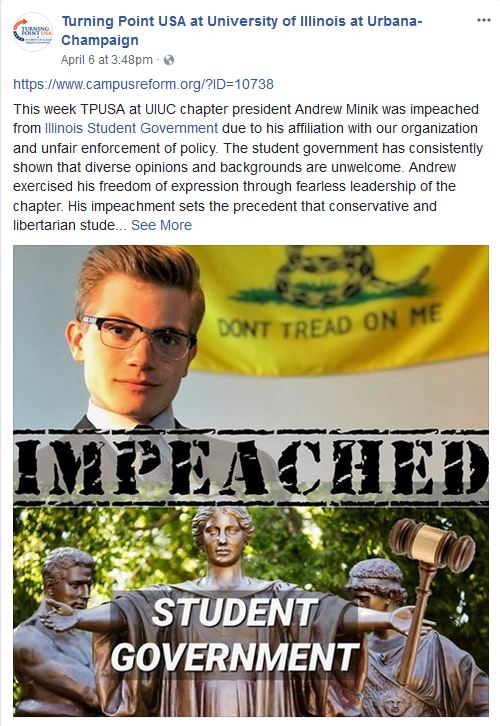
TPUSA UIUC announces chapter president Andrew Minik’s impeachment by Illinois Student Government as chair of Committee on Diversity and Inclusion. It is not true that he was impeached “due to his affiliation” with TPUSA. He was impeached because, among other violations, he forwarded a student’s information received in his capacity as committee chair that led directly to her being “doxxed,” harassed and trolled online. April 6, 2018.
In the 13-page formal articles of impeachment, the most serious charge among many concerned Minik’s role in organizing an anti-immigrant TPUSA event, “Building the Wall: A Memorial for Victims of Illegal Immigration.”
“In addition to his contributions to this event,” the articles of impeachment stated, “Minik also disclosed an email sent to him in his capacity as the Chair of the Committee on Diversity and Inclusion to members of Turning Point USA, who proceeded to publicly shame and harass that student on social media.” The student was by no means the first person TPUSA UIUC had harassed.
What happened was that the day prior to TPUSA’s quad event, Nancy M. Ramirez-Blancas, an employee at the La Casa Cultural Center, and president of the Illinois Coalition in Assisting Undocumented Students’ Education, emailed Minik expressing her concern over Turning Point USA’s event.
“Instead of responding to the message, Minik instead forwarded it to members of Turning Point USA, who proceeded to post the email on social media, with the inclusion of Ramirez-Blancas’ name ensuring easy recognition.”
TPUSA member Jose Valdez retweeted Minik’s email to his network. “Valdez’s twitter account boasts 2,600 followers, all of whom were signaled to target Ramirez-Blancas upon this tweet’s posting. The tweet was taken down soon after for violating Twitter’s terms of service regarding online harassment.”
For ISG, this was the final straw regarding their anti-diversity Diversity chair, and they impeached Minik April 4. “The distribution of this email to students outside of the organization [ISG] and the resulting breach of privacy and hostility constitute serious ethical violations by [committee] Chair Minik. The explicit targeting of an undocumented member of the campus community … compounds the malicious intent of Turning Point USA’s event.”
TPUSA complained on Facebook that Minik had been impeached “due to his affiliation” with them, which was not true. A piece about his impeachment was posted on Campus Reform, and he along with TPUSA head Charlie Kirk appeared on FoxBusiness Radio April 9.
On the TPUSA Facebook post about Minik’s impeachment, Bryton Mellott commented, “Drew was impeached for not doing his job. He did literally the opposite of his job by harassing students of minority status at every opportunity. He publicized through TPUSA a private email that came to him (as the chairman) from a concerned student, who was supposed to be assisted by his office and was instead harassed for trying to have a conversation with him. Drew was so objectively bad at his job that articles of impeachment had to be drawn up for chairmen, since they have literally never had a need to do so in the entirety of ISG. His incompetence is, by definition, unprecedented and the measure for his removal passed by much more than a 2/3 majority, on all grounds, and from a relatively moderate senate.”
Mellott knows whereof he speaks. He posted a statement July 4, 2016 on Facebook inspired by the Pulse nightclub attack on the direction the country is going, including a photo of him burning a flag. His statement was ignored, the flagburning image went viral, he garnered national media coverage, and received numerous online threats and attacks. Urbana police arrested him briefly for flag desecration, which is not illegal, and he won a wrongful arrest lawsuit in 2017.
TPUSA’s anti-immigration cardboard wall went up March 15.

TPUSA “Build the Wall” event, March 15. On left with upraised thumb is Joel Valdez, a TPUSA activist who has targeted UIUC grad student Tariq Khan, among others.
Two days earlier, on March 13, Michael Hari and three other members of the White Rabbit 3 Percent Illinois Patriot Freedom Fighters Militia, a domestic terrorist group in Clarence, located 35 miles northeast of Champaign, were arrested for allegedly bombing a mosque last August 5 in Minnesota and attempting to firebomb a women’s health clinic in Champaign last November 7. In April, 2017, Hari submitted a $10 billion bid to build Trump’s border wall.

Internet video of an individual, presumably Michael Hari, calling on militia members to come to Clarence and support the White Rabbit 3 Percent Illinois Patriot Freedom Fighters Militia, March, 2018.
Hari could be a poster child for an alt-right FBI profile, which would consist of the following.
–1993: attended Paxton schools. Studied criminology and criminal justice at University of Central Texas (now Texas A&M University-Central Texas). Graduated from University of Illinois Police Training Institute. Protested in Waco at Branch Davidian anti-government confrontation, which “galvanized,” that is, radicalized him politically.
–1995. Moved back to Paxton. and became a deputy sheriff until 1997.
–1997. Held meeting of Libertarian Party in a gun store he operated in downtown Paxton called Hari’s Gun Works, and made plans to run as a Libertarian candidate for Ford County sheriff. After serving as a Ford County sheriff’s deputy for 18 months, he was let go for “odd behavior” that included stopping “to help a woman whose vehicle broke down before searching her bag, handcuffing her and driving her to school in the back of his squad car.” Previously, Hari worked for the campaign of Sen. Kay Bailey Hutchison, R-Texas. Hari said he got involved with the Libertarian Party when he attended demonstrations in Waco in 1993. “Basically, Libertarianism stands for smaller government, cutting taxes, personal liberties. That’s what I’m for,” he said.
–2005-2006. Citing his membership in a splinter Old German Baptist Brethren group, Hari violates court order that granted child custody to his ex-wife in divorce, and instead abducted and took his two young girls to live illegally in Mexico and Belize for two years. TV host Dr. Phil hired an ex-FBI agent to find and return them, and their arrival back in Florida was filmed live on TV. Back in Ford county, Hari was sentenced to 30 months of probation in November, 2006. During the sentencing hearing, Ford County State’s Attorney Tony Lee argued for a jail term, saying that Hari “displayed classic criminal tendencies” and referring to a sentencing report that said Hari “rationalized the situation for his own benefit, minimized his own wrongdoing and projected blame onto others.”
–2016. In a News-Gazette letter to the editor, defended the 1857 Dred Scott case, which denied African-American Scott his freedom although he had lived in Illinois where slavery was illegal. Hari criticized an article that allegedly “contributes to the mythology in which Northern states were pro-black, Southern states were racist and Abraham Lincoln was a benevolent emancipator who led a crusade against Southern slavery. The truth is more much complex.” He continued, “The Dred Scott decision was a libertarian decision. U.S. citizens could lawfully carry their property [that is, slaves] into any state, regardless of local law. This decision would permit Texans to carry their assault rifles into California and Coloradans to carry their recreational marijuana into Illinois. Misrepresenting our history with regard to slavery makes villains and heroes out of ordinary people who merely held the values of their times.” This was too much for a usually right-wing News Gazette opinions page editor, who opined, “Given that Dred Scott is regarded by many as the Supreme Court’s worst decision, Hari’s letter also draws a vile connection between freedom and slavery.”
–ca. 2017. Unclear exactly when Hari founded White Rabbit 3 Percent Illinois Patriot Freedom Fighters Militia, also known as the White Rabbits. Members “wear ski masks, boots, olive-colored shirts and pants and a round patch depicting a white rabbit and the phrase ‘Ain’t No Fun When the Rabbit Got the Gun.’” The phrase is popular, especially in the American south. It refers to Walt Disney’s Bugs Bunny turning the tables and taking the gun Elmer Fudd uses to hunt him and turning it on him. By extension, it means turning the tables on someone, or the chickens coming home to roost. On Internet memes, it pertains especially to long-suffering women getting even with abusive males, or armed males standing up to law enforcement. The latter fits right in with the White Rabbit’s anti-government stance. The group says it practices “armed resistance”—“anything from simply marching or protesting with a weapon in hand to actively resisting government authority.” However, it also “claims it does not condone acts of violence such as terrorism, lynching or rioting. ‘We don’t do terrorism. We don’t do assassination. We don’t murder policemen. That’s not the kind of revolution this is,’” according to what a White Rabbit member says on one of the group’s YouTube videos.

White Rabbit 3 Percent Illinois Patriot Freedom Fighters Militia, also known as the White Rabbits, patch, Ain’t No Fun When the Rabbit Got the Gun
–April 2017. Submitted $10 billion bid to build Trump’s border wall. His company, Conflict Resolution Security Services, was housed in a run-down building in Clarence.

The building that housed Hari’s company, Crisis Resolution Security Services (CRSS) in Clarence, IL.
Provided details on a Website and several short YouTube videos. His bid would cost much less because it would follow not the actual border but run along existing highways, cutting distance significantly. It would also boast a wide road or pedestrian walkway on top, making it the only tourist-friendly border wall design.

According to Hari’s Crisis Resolution Security Services, “the proposal calls for two 26-foot concrete walls built on a 30-foot packed earth berm. In between the two walls would be more packed earth, topped by a narrow pedestrian roadway, like the Great Wall of China.” http://www.chicagotribune.com/business/ct-trump-border-wall-builders-0404-biz-20170403-story.html
—July 2017. Hari arrested for allegedly assaulting a neighbor in Clarence. According to the Ford County Sheriff’s Office, Hari got into an argument with his neighbor, supposedly used an “arm-bar takedown” maneuver on his neighbor to restrain him, and then pressed an Airsoft pellet handgun against the back of his head as he was being held face-down against the back of Hari’s car
–August 5, 2017. Dar al-Farooq Islamic Center, a Somali mosque, in Bloomington, Minnesota firebombed, causing extensive damage. It is located five miles from one of Trump’s last 2016 campaign stops, the Minneapolis/St. Paul airport, where he railed against “Somali terrorists.”
–November 7, 2017. Attempted firebombing of a women’s health clinic, the Women’s Health Practice, in Champaign. The only local clinic that performs abortions, among other women’s reproductive services, has been targeted by anti-abortion foes for years.
—February, 2018. Hari filed a federal lawsuit in central Illinois against the U.S. Secretaries of Agriculture and Health and Human Services, accusing their departments of violating his constitutional rights by doing the food-safety certification work that his firm, Equicert, does.“The People of the United States have rejected the Marxist doctrine that the government shall own the means of production,” he wrote, according to the court document. He requested a court order barring federal officials from interfering with his business.
–March 13, 2018. Hari and three others arrested by federal agents in connection with the Minnesota bombing and the attempted bombing in Champaign. Had planned to hold a protest the following weekend to oppose “the FBI and local law enforcement abuse” of Clarence’s citizens. “We plan to cook out and serve food,” stated a March 10 post on mymilitia.com under the screen name Illinois Patriot. “Please come and let the FBI know that breaking in doors, coercing searches and seizures, wiretaps and other such action is not acceptable in America. We are desperately hoping for some size to the crowd.” Earlier in March, the White Rabbits posted on YouTube a video in which its members wearing ski-masks called for other militia groups across the country to help them “take our town back.”
What does it all mean? Ford county sheriff Mark Doran knew of Hari’s organization and its contacts with other militant groups, but remained concerned after the arrest of four members. “Yeah, I’m still concerned about it because you have no idea” what could happen, Doran said. “I know [Hari has] had contacts in several different states, and we are aware of his contacts with other militia groups.” A scholar of anti-government extremism at George Washington University says that Hari “came up with … business schemes to make himself massively wealthy as a government contractor,” one of which was to build Trump’s border wall. “There could be a certain expectation in his head that he’s smart and should be successful and he’s not. It’s the government keeping him down.”
Most astute of all is Sheriff Dolan. “I definitely think it’s radicalization. And a lot of times this attracts the people who are on the fringe of society: they have poor living conditions, poor life experiences and you have somebody who leads them toward, I guess, what they would say is setting things right. Whatever that may be.”
What is clear is that the closer to home, the harder it is for the News-Gazette and many others to connect the dots, to acknowledge that this is actually happening here. Yes, they describe it as “homegrown domestic terrorism.” But they characterize it in ways that minimize, marginalize and otherwise trivialize it. The coverage focuses very narrowly, and avoids, ostrich-like, viewing the broader picture. For example, it reproduces the common narrative concerning “weird,” “unique” individuals, especially those often with mental issues, seemingly unconnected to other individuals or groups, but who apparently have few or no political ideas.
Thus, the News Gazette reports one of Hari’s group saying that they “did not intend to kill anyone.” According to the actual charge, however, Hari’s accomplice McWhorter said, “they did not intend to kill anyone, but they wanted to ‘scare them [Muslims] out of the country,’ because they push their beliefs on everyone … They committed the bombing mainly to ‘show them, hey, you’re not welcome here, get the fuck out.’” Moreover, the device itself was a “huge-ass black powder bomb.” Yet the News-Gazette and its sister paper portray Hari mainly as a colorful character, who has a “storied history,” and who “notoriously” served probation for abducting his own daughters.
Besides what the paper says, there is what it does not say. The News-Gazette referred to the videos posted both on building Trump’s wall, and Hari’s CRSS firm, but did not say anything substantive about them.
I pursued this, and in response to the News Gazette March 13 Hari story, I posted an online comment asking “how long will it take” the paper “to report this?” I quoted from two stories. First, an April, 2017 Chicago Tribune story quoted Hari on his wall in white nationalist terms. “The wall will be culturally significant, a powerful architectural statement of the determination of the American people to defend their nation and its Anglo-Saxon heritage, Western culture and English language.” Second, a March 14, 2018 headline story from Democracy Now! connected many of the dots. “The bombing of the Dar-Al Farooq Islamic Center in Bloomington, Minnesota, occurred on August 5. … The mosque is about five miles away from the site of one of President Trump’s final campaign rallies ahead of the 2016 election—during which Trump attacked Minnesota’s Somali community and compared refugees to terrorists.”
Online News Gazette editor Niko Dugan responded,
“Mr. Prochaska,
An extensive review of Michael B. Hari’s history by Will Brumleve, editor of the Ford County Record, will be published Friday [March 15] in The News-Gazette and at news-gazette.com. It includes references to his statements to the Chicago Tribune in April, 2017 about President Donald Trump’s wall.
Researching and verifying this information takes time, so I ask for your patience.
In addition, our coverage of Hari’s arrest thus far has made repeated reference to the government’s accusations against him regarding the bombing of the Minnesota mosque.
I am deleting the other versions of this comment that you have repeatedly posted, in an effort not to have to repeat myself.”
I responded to Dugan that
“1) The Friday 3/16 article by Will Brumleve does not say anything about Hari’s white nationalist beliefs as quoted by the Chicago Tribune article which I hyperlinked to and which Brumleve also mentions.
[This is what Brumleve says, “In April 2017, Hari told The Chicago Tribune that he drafted a $10 billion plan to build a wall along the border with Mexico, citing President Donald Trump’s call for such a wall. Hari drew up the proposal after launching a security company, Crisis Resolution Security Services, the newspaper said.”]
2) You say the News-Gazette has ‘made repeated reference to the government’s accusations against him regarding the bombing of the Minnesota mosque.’ Which is true.
What you have not done is link the mosque bombing to Trump’s nearby campaign stop close in time, and Trump’s anti-Muslim remarks made at that time and place.
In other words, you’ve said nothing about why a mosque, why that mosque, and why that mosque then.
Yet you delete my comments ‘in an effort not to have to repeat’ yourself.
Rather than portraying Hari’s group as ‘homegrown domestic terrorists,’ as Shenk and Zigterman say, you might consider connecting the dots between his group, white nationalist beliefs, and Trump’s anti-Muslim statements.
Unless you’re ok with not telling your readers that side of the story.”
The second article, datelined March 16, did indeed add a few pertinent background details.
Given Hari’s Dred Scott letter to the editor, it doesn’t require any particular acumen to connect the dots and follow up on leads when they are all provided by others. To not do so, however, preserves the comforting thought that they are not at all like the Republicans and conservatives that run the News-Gazette. Thus, the News-Gazette concentrates on what is “storied” and “notorious” about Hari, while it studiously avoids the history of right-wing radicalism and white supremacy in Champaign and East Central Illinois, including:
Sundown towns and the Ku Klux Klan.
The first America First movement (1930s-1940s).
Guns Save Lives, Rantoul and Savoy
The News-Gazette’s far-right owner Marajen Stevick Chinigo and John Hirschfeld, the paper’s lawyer, columnist, and David Duke supporter, among others.
UIUC’s own anti-Semitic and white supremacist faculty member Revolo Oliver (1945-1977).
UIUC’s McCarthyite 1940s and 1950s purges, including President David Stoddard, and Keynesian economics department faculty, including future a Nobel prize winner.
Still more significant is the relative lack of coverage and refusal to place the abortion clinic attack in context. The mosque bombing occurred in Minnesota, but the clinic attack in Champaign occurred only blocks away from the News-Gazette offices. Yet much less coverage was devoted to the latter compared to the former, even though abortion clinic attacks are much more common and have been going on much longer. On the day the attack was reported, Champaign Police Deputy Chief Troy Daniels stated, “it’s very possible that the reason the device ended up here was because of someone who may have something against what occurs in the building.” This is a radical understatement, but if the News-Gazette had been motivated to inquire further, they could have started with the online comments to their own story.
#1
CallSaul wrote on November 07, 2017 at 10:11 am
Hmmm…
Looks like we may have a local RWNJ [Right-Wing Nut Job] domestic terrorist of our very own …
If that’s what this turns out to be—and really, what else could it realistically be?—this terrorist needs to be caught and needs to go to jail for a long long time. …
The Gipper wrote on November 07, 2017 at 12:11 pm
It’s nothing compared to all the terrorism that goes on inside on a daily basis. But never mind, that’s just blobs of tissue.
“Women’s Health” Practice. What a joke.
Should have an appropriate name, like Murders ‘R’ Us.
CallSaul wrote on November 07, 2017 at 12:11 pm
And of course a RWNJ troll justifies this act of domestic terrorism …
Exactly as expected …
But hey, this is the good kind of terrorism, amirite…?
Another fine upstanding example of RWNJs in America today …
Disgusting … but entirely predictable …
Turns out “Call Saul” was right, and “The Gipper” was not alone. The National Abortion Federation’s annual report for 2017 put Hari’s attempted Champaign firebombing in context. “There was an overall decrease in acts of vandalism against clinics but … a major upsurge in trespassing [247 in 2016 to 823 in 2017], obstruction [tripled to 1,704] and blockades … threats of death or other harm nearly doubled to 62.” The federation’s president said, “The protesters are feeling emboldened by the political environment and seeing what they could get away with.”
According to the report, “the one attempted bombing in 2017 involved a pipe bomb that did not explode after being placed in an abortion clinic in Champaign, Illinois, in November. The three men charged by federal authorities are allegedly part of a militia group called the “White Rabbits,” who also have been charged in the bombing of a Minnesota mosque last year.” The News-Gazette ran the Associated Press story, but cut the paragraph on the Champaign clinic attack in its print edition.
Politically hard right—I would argue alt-lite—the News-Gazette is, if anything, still more conservative when it comes to gender, abortion, same-sex marriage, LGBTQ, and related issues. Pretty much everyone in an editorial capacity, beginning with Jim Dey, is anti-abortion, anti-LGBTQ, and anti-same-sex marriage. Many editorials and op-ed pieces, especially by master dissumulator Dey, mask their views using indirect statements and innuendo. But if you pay attention, it is easy enough to see. Pro-transgender conversion therapy. Supportive of local anti-LGBTQ bed and breakfast. Let me stress that this is in addition to the vile, disgusting anti-abortion, anti-LGBTQ and other hate-filled letters to the editor that appear in the paper week in and week out. For example, Syrian chemical attacks on civilians are said to be just like chemical abortions.
Not all those who agree with “The Gipper” about abortion are violent. And not all those who agree with Hari’s politics are violent. But just as Hari embraces violence and engages in domestic terrorism, so, too, do some anti-abortion advocates. For those who characterize abortion as “murder,” a “Holocaust,” it is just a step to arguing that women undergoing the procedure should be treated as murderers. “More abortion opponents should be willing to acknowledge that treating abortion as murder necessarily means treating women as murderers.” Thus, fringe columnist Kevin Williamson says that women who have abortions should be hanged, and that “I believe that the law should treat abortion like any other homicide.” The only thing that distinguishes Williamson is that for a short while he moved from the unacceptable right-wing fringe to the respectable mainstream Atlantic, before they fired him for his de facto fringe views.
Moreover, just as Hari’s White Rabbits militia both firebombed a mosque and attempted to firebomb an abortion clinic, so, too, such anti-Muslim and anti-abortion views often go together. Similarly, some libertarians intent on putting libertarianism into practice embrace authoritarianism in order to do so. Worse, these and other people feel increasingly empowered since the 2016 election to trumpet their twisted views and to act on them. Tolerance for white supremacists dovetails with intolerance for women’s reproductive rights. For them, Trump is hailed as both an anti-immigrant white supremacist, and an anti-abortion extremist.
“… Trump is not a politician. He speaks his mind and never apologizes to those who disagree.
Politicians spend most of their time backtracking or saying nothing of substance. This country needs a little truth right now. Snowflakes beware.
I am a white male, and to be honest, I don’t give a hoot about the history of American slavery, the history of LGBTxyz, safe spaces, inclusion, diversity or [columnist] Leonard Pitts [“liberal shrieking”].
I do care about border security and making America great again.
Deport illegal aliens and bring back the Chief.
For these views, I will never apologize.
DAVID CHRESTMAN
Monticello”
While such ideas are all too widespread, such extremist groups as the White Rabbits are, thankfully, numerically small. So, too, is TPUSA UIUC, for example. Yet several things are cause for concern. Many individuals and groups, especially the alt-lite with ties to the alt-right, have access to significant funding, including deep-pocketed donors. Second, they enjoy access to established networks that reproduce and retransmit their messages. Third, individuals and institutions, blithely or willfully blind to the threat these groups pose to liberal democracy, allow themselves to be gamed over and over again, directly and indirectly providing the soil, the fertile muck in which they thrive and grow into twisted plants
Again, even when pointed in the right direction, the News-Gazette prefers not to look. Hari’s arrest was reported March 13. TPUSA held their pro-Trump wall event March 14, which was reported on March 15. The same day I posted the following comment.
“#23
David Prochaska wrote on March 15, 2018 at 8:03 pm
Just a coincidence I’m sure
http://www.news-gazette.com/news/local/2018-03-15/protesters-converge-ui…
Protesters converge on UI Quad as student conservatives build ‘wall’
Thu, 03/15/2018 – 1:23pm | Adalberto Toledo”
And at least one other reader also noted the coincidence.
“#24
jparks wrote on March 15, 2018 at 9:03 pm
Yeah I caught that too.”
The following day in my March 16 comment, I wrote:
“You might also pursue whether it is mere coincidence that TPUSA held a pro-Trump wall demonstration on campus 3/14 within a day of the Hari story breaking.”
It is true that Hari’s militia is small, and that, luckily, no one has been killed. Most of the charges are for attempts or plans to commit crimes, not crimes actually committed. Most serious were the two fire-bombings, and the second one of those literally fizzled. No one knows how widespread their support actually is. Just four were arrested for criminal violence. On the other hand, they “claim that about half of the homes in … Clarence have at least one household member who belongs to their group,” although one resident disputes this.

Flags, including a Confederate flag, displayed in the windows of a house across the street from neighbor Annette Nicholson’s home in Clarence, March 30, 2018.

Flags displayed in the windows of a house across the street from neighbor Annette Nicholson’s home in Clarence, March 30, 2018.
According to a White Rabbit YouTube video, they say that the federal government “became aware of our organization; they became aware that it was gaining some power and some traction and that our little community actually represented a lot of the people [in the group], and they decided to crush that, to put an end to that, by terrorizing the people. And that just absolutely cannot stand.” It continues, “You can read what we believe on our website …There’s some kind of inflammatory language on there, but if you read what we’re really about, it shouldn’t be controversial to any American … We stand against the regulation and taxation that’s taken over this country, the political correctness, just plain socialism that’s creeping up everywhere we look. … If you feel like your freedoms are being curtailed and every day you’re getting a little further away from the country you grew up in, then probably you’re already one of us.” Numerous houses in Clarence fly a Confederate flag. Sheriff Doran says they are in touch with if not connected to other militias.
In another example of the overlap between the alt-right and alt-lite, and how they share symbols and memes, both Hari and Minik fly the Don’t Tread on Me flag, or Gadsden, flag, the one most frequently connected to white supremacists after the Confederate flag. “In recent years, the Gadsden flag has become a favorite among Tea Party enthusiasts, Second Amendment zealots—really anyone who gets riled up by the idea of government overreach.”
Don’t Tread on Me flag in front of building owned by Hari http://www.news-gazette.com/news/local/2018-03-15/militia-mystery-arrests-bombing-suspects-were-planning-government-protest.html#comment-690250 .
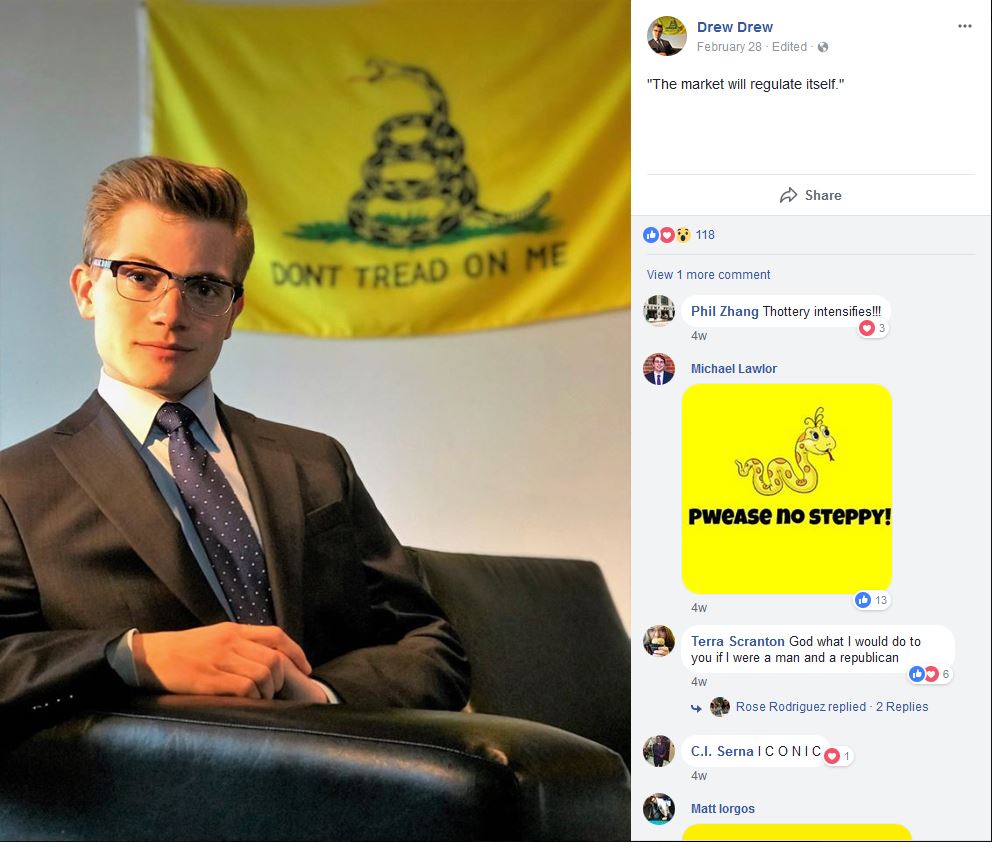
MINIK’S FB TPUSA UIUC leader Andrew Minik, Facebook home page, Don’t Tread on Me flag on wall in background.
At first glance, such symbols and memes may seem harmless, unimportant, and insignificant. Remember, though, that the cult-like nature of many of these groups function as an in-group to outside society, and nothing keeps outsiders out like in-the-know shared symbols, practices, and rituals. 4-chan-turned alt-right sets itself off against “normal fags”; their slogan is “kill all normies.” Yes, the Don’t Tread on Me flag does not constitute physical violence, but for some it is considered as racially hostile as the Confederate flag. It is no coincidence that it is whites using it and Blacks critical of it. So when Minik recently changed his Facebook home page photo for one including the Don’t Tread on Me flag, he knew exactly what he was doing, he knew exactly the message he was sending.
Key to understanding how such signs and symbols work, indeed, what the alt-right alt-lite is, and where it came from, is social media.
The Social Network (2010), the story of Mark Zuckerberg and Facebook, is actually about networking through social media. And this is what Trump and his supporters did, as we will see below. The crucial scene in The Social Network occurs when everyone in a bar realizes that everyone else is not in a public sphere but on social media, “plugged in” to each other and “networking” on Facebook.
Social media = social + media, where “social” is our human, social world, aka empirical reality, and “media” is the technology of the Internet, a human and social construct, a representation of the “social.” Funded initially by the government (DARPA and DOD), it was then given over to private corporations to make a profit.
Social media have become our contemporary “public sphere,” defined in 18th and 19th century Europe before the era of mass politics (parliamentary government, universal male suffrage) as those gathering places, usually watering holes such as bars and cafes, where people gathered and conversed, where news of the day and ideas were discussed and debated.
Today, social media constitutes to a large extent the public sphere. In-person social exchange—sociability—is replaced by person-to-device exchanges via social media platforms (Facebook, Twitter, Reddit). Earlier public spheres were limited in the number of people who participated, and their connections in geographical space, as well as time. Contemporary social media tout “connectivity”—we are all connected all the time—but personal exchange is limited to interfacing not person-to-person but via technological devices in virtual reality. A quantitatively greater number of more frequent, briefer, and more superficial connections corresponds to a qualitative impoverishment in the quality, richness, and depth of sociability. Broad connection in time and space, yes, but limited—now up from 140 to 280 characters on Twitter. Via social media we present machine-generated, highly mediated facets of ourselves versus earlier public spheres that circulated newspapers, broadsheets, handbills.
Thus, the Internet constitutes a technological interface (media) with our empirical reality (social). Most of us do not realize most of the time that it is not reality, but a representation of reality—a virtual reality—albeit a powerful and increasingly verisimilitudinous one. As such, there are, theoretically, limitless ways to configure and connect, to make these media immediate to our lived reality. That’s where the creativity comes in, to fit the zeroes and ones to the world out there, to make the virtual feel more like the real, to achieve a greater reality effect. For the closer the fit, the greater the probability that we will learn to need it, the more likely that more of us will be willing to pay for it, and the more likely tech firms can increase market share and make more money.
Social media could enhance the general welfare, the public good. Instead, it reproduces the history of U.S. consumerism, the history of broadcast communications, first radio, then TV. “Regulating” broadcasters primarily means licensing, which means selling slots (AM, FM, VHS, cable) at ridiculously low prices compared to the enormous profits private corporations make in their respective media “markets.” Public and independent non-profit broadcasting, such as it is, is an underfunded, barely tolerated afterthought. Like TV and radio, the Internet has been given away by the state basically for free to corporations. To make matters worse, net neutrality applied to all service providers is increasingly undermined by the government at the behest of greedy corporations after more market share.
And to play devil’s advocate for a moment, how much do we really need these technological bells and whistles when it comes right down to it? How much of social media makes a genuine contribution to our lives—something that is absolutely essential, that we cannot live without? Food and water are necessities, healthcare and public education should be services provided by societies. But how much do we need Yelp, for example, as opposed to convincing ourselves that we need it? How much value do they actually add to our lives? When you compare the amount of money these companies make to what it costs us, there is no question that their “value added” services do not measure up.
More crucially, how much are we willing to pay for social media, both in cash and the loss of privacy? To monetize these apps, tech companies turn over our information to advertisers to sell us stuff. Does everyone understand that, for example, Facebook’s business model is diametrically opposed to our privacy, that its need to vacuum up all our data, without effective restrictions, in order to sell it to advertisers is diametrically opposed to our privacy rights? The only way it and other companies can make money is to “mine” our personal data. “Mine,” as in “exploit,” “dig up.” The more their revenue increases, the more our individual privacy shrinks.
By any reasonable measure, these companies and their CEOs are outlandishly overcompensated financially, and way overvalued in their outsized social and political as well as economic status relative to the value they add to society. Beyond the human convenience, where exactly is the social value?
Perhaps the supreme irony is that for extremist, anti-statist libertarian types like Thiel, and his Silicon Valley ilk, it was the government that created the Internet with public taxpayer money, and then gave it away to private corporations so that people like Thiel could reap millions and billions in profits, and then turn around, and tout radical individualism, the genius of “entrepreneurs,” “free markets,” in the process becoming among the most vocal libertarian opponents of the state, of government programs, of the common good. Only in America.
The government agencies that have been showering Thiel’s Palantir big data firm with government contracts, that have been in bed colluding with AT&T and other service providers to illegally tap our phones in the 1990s, are today colluding with firms to appropriate artificial intelligence technology such as GPS to target “bad actors” in drone strikes and kill them, never mind the “collateral damage” of civilian deaths in these state-sponsored terrorist acts of assassination. It has gotten to the point where 3,000 Google engineers pushed back—James Damore not included—writing their upper level managers that this was collusion they did not want to be a part of. Back to the future, or is it regression to the mean, considering that while it is a few computer engineers now, it was a handful of physicists back in the 1940s who invented the atomic bomb, then regretted it? Robert Oppenheimer then, Edward Snowden now.
The building blocks of Internet grammar consist of shorthand communicative units: stripped-down (and anonymous) avatars, emojis, and especially memes. Social media dumbs down communication at the same time that the Internet “hive mind” spawns memes and themes that go viral and take on a life, and meaning, of their own.
Most people do not realize that not only is Trump Internet Troll #1, but that the Internet of 4chan, /pol/, and /b/ already had voted for Trump in 2015. “Trump has awoken the mainstream media to the ‘alt-right.’” 4chan may not be identical with Trump’s base, but it is a close fit. Certainly, Trump’s Internet trolls speak for large numbers of his base. “The alt-right is associated with Trump, 4chan, and anti-Semitic Twitter trolling.”
What happened was that as the hacktivist group Anonymous was repressed by the FBI, and other federal agencies, out of existence on 4chan’s /b/ board, what became the alt-right filled the vacuum created thereby.

Anonymous, 4chan. Pepe the Frog takes over the world, a widely shared emblem for /pol/, the political discussion boards on 4chan and 8chan.
A green anthropomorphic frog with a humanoid body, Pepe first appeared in a series of comics by Matt Furie on 4chan. In the comic, Pepe urinates with his pants pulled down to his ankles with the phrase “feels good man” as his only rationale. “My Pepe philosophy is simple: ‘Feels good man,’” Furie said. “It is based on the meaning of the word Pepe: ‘To go Pepe.’” At this point, “he was a lovable character, known to poke fun at the establishment but certainly not burning any crosses.”
Pepe the Frog became an Internet meme when its popularity steadily grew on 4chan and elsewhere in 2008. 4chan was considered the meme’s “permanent home” where it took off among 4chan users, who adapted Pepe’s face and his catchphrase to fit different scenarios and emotions ranging from melancholy and anger to surprise. “4chan users referred to those who used the meme outside the website as ‘normies’ (or ‘normalfags’) in response to the meme’s increase in usage.” By 2015 Pepe had become one of the most popular memes on 4chan and Tumblr.
During 2015 and 2016 the meme was appropriated by and “jumped” to the alt-right, as it became connected to Trump’s campaign. When Trump retweeted a Pepe representation as himself, the circle was closed.
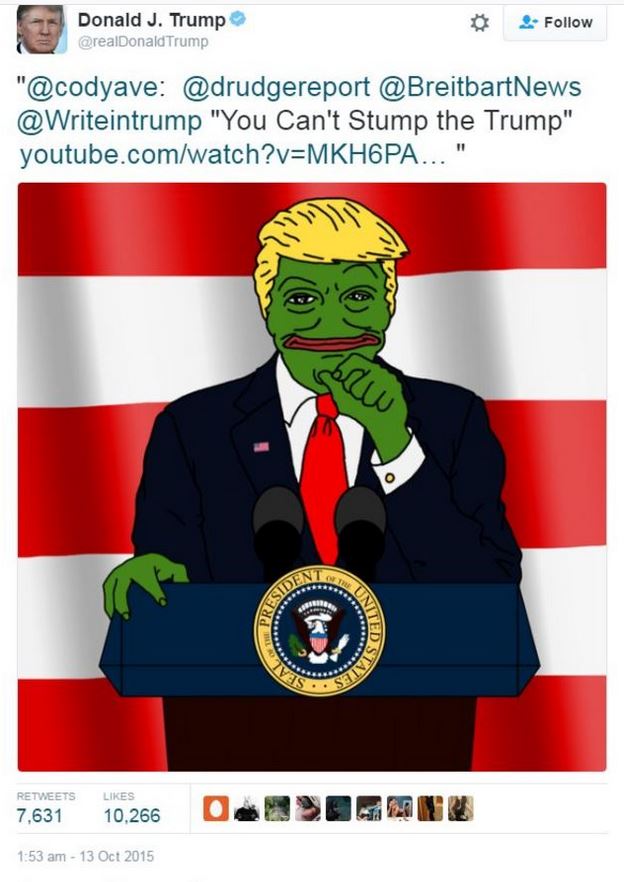
Donald Trump as Pepe the Frog. Trump retweets “You Can’t Stump the Trump (Volume 4),” October 13, 2015. Note links to alt-right alt-lite sites the Drudge Report and Breitbart News.
In retrospect, we can see that Trump had won the 2016 election by October, 2015.
An outfit like TPUSA UIUC was just one of many alt-right alt-lite groups relatively slow to reproduce and retweet the now-white nationalist Pepe the Frog meme.
As for Pepe’s creator, Furie publicly expressed dismay at Pepe being used as a hate symbol. News organizations picked up on Pepe’s use by white nationalists and the alt-right during the 2016 election. The Daily Beast reported “an actual campaign to reclaim Pepe from normies,” and that “turning Pepe into a white nationalist icon” was an explicit goal of some on the alt-right.
Soon, however, two sources for the Daily Beast article told an alt-lite news site that they had coordinated beforehand to mislead the reporter with the expectation that she would uncritically repeat what they told her. As one said, “Basically, I interspersed various nuggets of truth and exaggerated a lot of things, and sometimes outright lied—in the interest of making a journalist believe that online Trump supporters are largely a group of meme-jihadis who use a cartoon frog to push Nazi propaganda. Because this was funny to me.”
What all this demonstrates is that Pepe the Frog is an excellent example of how an originally humorous, progressive meme on 4chan was appropriated by the alt-right that later took over 4chan, next was disavowed by its original creator, then was embraced by Trump and appropriated by his supporters very early in the 2016 campaign, only to be disavowed as an alt-right symbol by self-admitted Trump trolls. Thus, the alt-right alt-lite continues to use Pepe, claiming a nod-nod-wink-wink plausible deniability that it is a white nationalist symbol, using the trolling-style humor of Anonymous for its own ends, and gaming everyone in the process. Most important, the alt-right alt-lite denizens of the Internet harnessed it to Donald Trump’s illiberal, authoritarian politics. As a result, they largely ended the hegemony of the mainstream media—what 4chan users call “normies”—and provided a no-holds-barred forum for other parties domestic and foreign intent on electing Trump, and in the process heralded the coming-of-age arrival of increased conspiracy-mongering, fake news, post-truth, and lies 24/7/365.
Time to draw up a balance sheet. Today, we may characterize the core issue as (economic) libertarianism + (political) autocracy versus (liberal) democracy. This has scrambled what we think of as “left” and “right,” “liberalism” and “conservatism.” Most people most of the time do not consider the Right—Republicans, libertarians, alt-right and alt-lite—“extremists” and “radical.” But in wanting to “tear it all down” (Buchanan), “burn it to the ground” (4chan user, 1st article), “destroy it all” (Bannon), indeed they are. In this contest, Democrats are—ironically—conservative, because they want to preserve (liberal) democracy. In this case, it may be more useful to visualize politics as a circle where the far Left touches and morphs into the far Right, and vice versa, instead of as the more commonplace spectrum that ranges from Left to Right. Admittedly, this circular model is commonly discredited as out of date. However, this may be a moment when it is “good to think.”

Appropriated by TPUSA, this factually false slogan regarding socialism originates in the radical libertarian and anti-statist views of extremist ideologues such as Koch favorite James Buchanan, as delineated clearly in historian Nancy MacLean’s important Democracy in Chains.
Several authors ‘good to think’ flesh out these schematic remarks. In a surprisingly prescient piece just before the 2016 election, commentator Jonathan Chait argued that “the [Republican] party is lurching toward a synthesis of libertarian (economic) ends harnessed to authoritarian means.” Disputing “the conventional wisdom [that] sees the party as deeply and irrevocably split between its elite … wing and its Trump wing,” Chait argued that “advocates of the traditional party economic agenda,” from Paul Ryan and Grover Norquist to the Wall Street Journal editorial page and the Koch brothers, were all already giving Trump “at least muted support.” The real issue for conservatives is that “economic libertarianism contains an intrinsic fear of the majority using the ballot box to redistribute resources from the few to the many.” Chait identified that “terror” as “the basis of Ayn Rand’s novels, which inspired Paul Ryan’s career in public life.” He concluded with a warning that Peter Thiel “is a helpful illustration of the reality that right-wing libertarianism is far more comfortable with authoritarianism than you might presume.”
Both Chait and Paul Krugman have written powerfully about “movement conservatism,” which dates from the 1980s, and which they sharply distinguish from more traditional Republican-style conservatism. Writing in the alt-right alt-lite present, columnist Michelle Goldberg contrasts conservative ideas pre- and post-Trump, and notes that to understand national politics from the 1980s “you had to understand certain conservative ideas.” She draws on historian Daniel Rodgers, who described how in the 1980s “Novel forms of intellectual production and dissemination—more politically oriented think tanks, new journals of scholarly debate and opinion, more argumentatively structured media—now began to move ideas more aggressively into circulation.”
“Trump put an end to that,” Goldberg writes. “The field of ideas has gone from being the ground on which politics are fought to a side in politics.” She continues, “[i]nasmuch as there are ideas bound up with Trumpism, they are considered too disreputable for most mainstream publications. An opinion section that truly captured the currents of thought shaping our politics today would include Alex Jones, the conspiracy-mad Sandy Hook truther; the white nationalist Richard Spencer; and CliffsNotes fascist Steve Bannon.”
Goldberg’s conclusion is sobering. “Most supporters of liberal democracy, on the right as well as the left, realize that once we treat issues like religious freedom and the desirability of racial equality as matters for debate rather than as first principles, we are lost.”
These core ideas of the Right (from Republicans and conservatives to the alt-lite and alt-right) are perfectly distilled by the Koch brothers’ intellectual, libertarian guru, economist James Buchanan. In his essay “The Samaritan’s Dilemma” (1975). Buchanan perversely turns the famous parable inside out. “We may simply be too compassionate for our own well-being, or for that of an orderly and productive free society” (p. 142). In Buchanan’s twisted inversion of the parable, the Jewish traveler he helps becomes the “predator,” and the Good Samaritan becomes his victim. Why? Because “modern man”—the Good Samaritan—“has become incapable of making the choices that are required to prevent his exploitation by predators of his own species”—such as the Jewish traveler! Libertarians do not rend the social safety net; they destroy it completely.
This is where the right-wing echo chamber gets sucked down the rabbit hole, and, Alice-in-Wonderland-like, everything turns topsy-turvy and upside-down. For example, the Right argues that the idea of a “shared good” is a fiction, because it violates the economic “freedom” of the minority. They believe that the government steals property when it collects taxes. They believe that the government that steals in taxes is exactly like a thug in Central Park. The 47% of citizens Romney referred to in 2012 is straight out of the Heritage Foundation’s annual “index of takers.” Arlie Hochschild describes how many folks resent “cutters”—people who cut in line and are given preference—and “takers,” recipients of various kinds of government welfare.
It goes on and on. In order to increase tax revenue and cut taxes, Arthur Laffer argued in the 1980s and is still arguing it today. Sometimes these are simply what Krugman calls “voodoo ideas,” stupid ideas that keep popping back up. Sometimes, correct, evidence-based ideas are counter-intuitive, for example, that Keynesian deficit spending counters economic depression and jump-starts growth.
Historian Nancy MacLean argues that the Koch brothers’ libertarian idol, James Buchanan, wanted to “Tear down the idea of the public interest, of the public good.” To replace it with radical individualism, the notion that the interest of the individual is paramount. Buchanan’s work was all theoretical. Based on game theory, there was no empirical data or analysis. Take a minute to let that sink in. For Buchanan and his ilk, the government consists of predators preying on people. Justice would be “I keep what I make, you keep what you make.” No wonder that Buchanan, the Koch brothers, Thiel and other libertarians are okay with authoritarianism: they realize that in a democracy no majority is going to freely vote in favor of such libertarian ideas.
A related issue is the personal makeup that leads such individuals to espouse such extremist, anti-social views. MacLean does not write about this in her book, but in a presentation on YouTube she speculates that a “high number” of Buchanan’s followers, and libertarians more generally, rank high on the “autism scale.” As we have seen, this is true of James Damore, and the same argument has been made regarding Peter Thiel, among others. That Hans Asperger, the inventor of Asperger’s syndrome, was a Nazi, and Asperger’s syndrome has a tangled history with autism adds a further wrinkle.
The antithesis of the libertarian core of conservatism is a vision of European social democracy, of American liberal democracy ably articulated by historian Joan Scott

Grover Norquist, extremist head of Americans for Tax Reform, has been calling for limiting goverrnment—and services—for decades. He is known for his infamous statement wanting to shrink the size of government down so it could be “flushed down the bathtub.” For such ideological extremists, government can do no right, and business can do no wrong; by extension, nothing is right with government bureaucracy, and nothing is wrong with business bureaucracy.
The antithesis of the libertarian core of conservatism is a vision of European social democracy, of American democracy ably articulated by historian Joan Scott.
“What I mean by the common good is that we understand we’re all part of something bigger than ourselves, that we live in societies together and must help take care of one another because you never know when you’re going to need to be taken care of by others. And it’s not enough to say that your family or your church is going to take care of you. Societies are collective entities, we’re meant to be connected to one another; the function of government is to administer that connection. We’ve increasingly lost that sense of community, of the notion that there is something we contribute to and benefit from that is called the common good. I think I would date the beginnings of that loss to the Reagan administration and to the notion that somehow we were all separate individuals who only ought to be interested in ourselves. There were a number of court cases in the early ’80s when class-action suits were brought, only to be thrown out by Reagan judges on the grounds that individual injury had to be proven, that you couldn’t use statistics about discrimination in the labor force. You had to have individual cases and each one had to be remedied as an individual matter. There was the tax reform movement that treated progressive income taxes as assaults on individual autonomy rather than what they are—a shared responsibility for ourselves and others in the society that we all live in. People began to say they didn’t want to pay property taxes any longer because they had no children in schools (and most property taxes were used to support the public schools). As if the education of society’s children didn’t have an impact even on childless people! The common good is the notion of shared collective responsibility and reciprocity. It’s that that we’ve lost… The late ’80s and ’80s [Reagan, Thatcher]—that’s the beginning of the turn away from collective responsibility to a kind of selfish individualism that we now associate with or call neo-liberalism.”
To stand stock still, remaining committed to liberal democracy, to European social democracy, as the U.S. hurtles headlong hard-right, more and more looks liberal, progressive—and radical.



